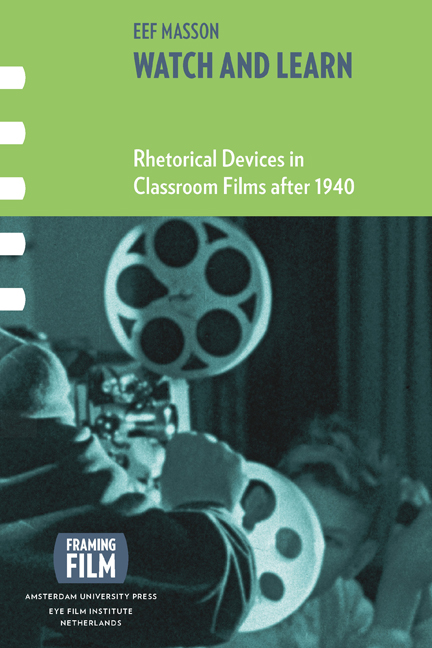Conclusions: Towards a Conception of the Dispositif Notion as a Comparative Tool
Published online by Cambridge University Press: 20 January 2021
Summary
In one of the first pages of this book, I quoted a statement by Schoevers, NOF director-to-be, in which he strongly emphasises the textual peculiarities of the classroom film. In the excerpted section he argues that classroom films are fundamentally different from other audio-visual texts, even (more broadly) educational ones. For the author this distinctness is a sine qua non: shorts that do not contain the ingredients mentioned, in his view, simply do not deserve the label ‘classroom film’.
About fifteen years later, Peters, one of his successors, followed a rather different logic. In his manual Visueel onderwijs, he characterises the classroom film not in terms of its textual features but with reference to its viewing conditions. He writes:
It should indeed be observed that a pupil, in his experience of a film, is very receptive to anything that the maker may want to communicate. In a regular cinema, this receptivity can lead to a more than normal suggestibility, so that the critical mind no longer intervenes to judge the correctness of the information given. The class situation, however, differs considerably from the theatrical situation. The factors which play a crucial role in a cinema setting (the easy cinema chair, the yearning for divertissement, the anonymity of the viewer, the absolute darkness and isolation of the theatre, the ‘surrender’ to the authority of the film-maker and the identification with the hero or heroine of the story) are mostly absent in the classroom. The obfuscation of the room, the involuntary perceptivity to everything that can be seen on the silver screen and the realistic character of the film can make the pupil more receptive to what is shown, but in itself, this is only an advantage. Suggestibility presupposes the fading into the background of the intellectual, critical functions of the mind; receptivity in contrast does not exclude activity of imagination and reason but rather facilitates it. (1955, 24)
Although the author claims elsewhere that the titles his institute provides have their own distinct features, he focuses here on what the classroom situation itself contributes to their functioning as teaching films. The circumstances of the screening, he suggests, entail that such shorts affect their spectators in different ways than films shown in theatres.
- Type
- Chapter
- Information
- Watch and LearnRhetorical Devices in Classroom Films after 1940, pp. 241 - 254Publisher: Amsterdam University PressPrint publication year: 2012



